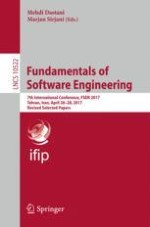2017 | Buch
Fundamentals of Software Engineering
7th International Conference, FSEN 2017, Tehran, Iran, April 26–28, 2017, Revised Selected Papers
herausgegeben von: Mehdi Dastani, Prof. Marjan Sirjani
Verlag: Springer International Publishing
Buchreihe : Lecture Notes in Computer Science
